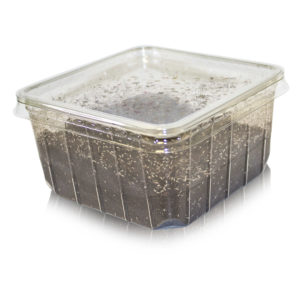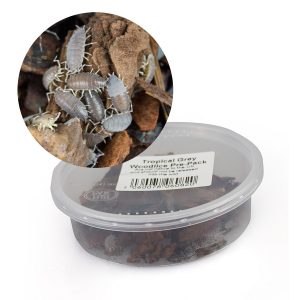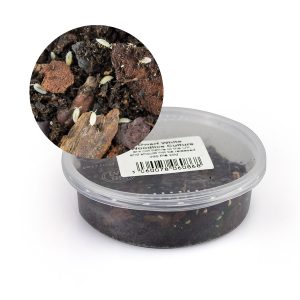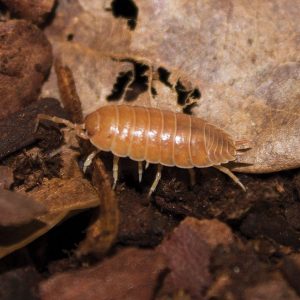Copyright 2021 Evolution Reptiles
All rights reserved.
Copyright 2025 Evolution Reptiles
All rights reserved.
All rights reserved.
When we’re talking about our bioactive systems we often refer to the ‘clean up crew’ (sometimes just written as CUC), or ‘cleaner bugs’. These are the various species of animals that live in the soil of the bioactive vivarium to break down waste products into plant food. Dead leaves, rotting wood, shed skins and faeces are all processed by these helpful little creatures, and as a bonus some of them may well end up as a meal for the intended main tenant of the habitat.
So what sort of bugs should we be using, and how do we keep them healthy?

Springtails. These are the basis of your clean up crew, as they process everything from larger items of waste right down to fungal spores and bacteria. They are called ‘springtails’ because they have an appendage at the back of their body (called the furcula) that is folded back when the springtail is pottering around in the substrate. If threatened, this appendage is released and the end of it hits the ground with some force, flinging the springtail into the air and away from the threat.
If you turn over a clump of damp leaves you will see a large number of these tiny pale creatures pinging off in all directions – that’s the furcula in action! All of this takes place in as little as 18 milliseconds.
It’s worth integrating springtails early in your build, allowing them to build up numbers before you introduce the final inhabitant of the habitat that you’re creating. Obviously, they need food – and luckily, they’ll eat pretty much anything. They are what’s known as detritivores, which means that they eat dead, decaying material, or detritus. You don’t, however, need to pile your new bioactive system with piles of rotting food to keep them happy! Dead leaves (which you will be using plenty of) are a great place to start, and you can also use a small number of vegetable peelings or a small amount of fruit. If fruit flies are a concern, then there is actually a food specially formulated for springtails that can be sprinkled over the substrate to give them a flying start.
There are many different species of springtails, with some that are specially adapted to live in harsh environmental conditions such as snowfields or deserts. Most species, however, are quite happy at normal room temperature, and will reproduce without any further interference from the owner.
Some people express concern over the possibility of escape; springtails – like some of the other species on this list – like it damp, as they breathe through their skin. Our homes are too dry for them to survive for long, so they will tend to stay in their nice cosy substrate where there are many places to hide, and plenty to eat.
Be prepared to keep a separate colony going if you intend to keep dartfrogs – they love to eat them!
Woodlice. Several different species are available to buy, and there are many more to be found out in the wild – there are 45 species of native and naturalised woodlice in the British Isles alone! Woodlice are crustaceans, related to lobsters and crabs, and breathe using gills rather than lungs. As you might imagine, this means that they are happiest where it is damp. Female woodlice carry their eggs in a pouch on their undersides, and when the babies hatch out they keep them there for a couple of days until they are strong enough to fend for themselves. The babies are miniatures of the adults, and shed their skins several times before they become fully grown.
They are usually nocturnal and are detritivores, which is what makes them useful in our bioactive habitat. Vegetation is their favourite, such as rotting wood and dead leaves, but they will help to break down all sorts of debris that they find in the substrate.
Many animals find them highly palatable, and due to the heavy exoskeleton they are particularly high in calcium which makes them an excellent food.

Tropical grey woodlice: These are a tropical species (Trichorina species) that grow to around 1.3cm, and will consume any organic matter. They are large enough to provide a food source for crested and gargoyle geckos, and if given plenty of shelter and food will breed prolifically and provide an ongoing food source. They do appear to be particularly fond of dead leaves.

Dwarf white woodlice: Another tropical species (Trichorhina tomentosa), these are the smallest of the three species we sell. Adults are 5mm long, and the babies are (obviously) even smaller, so make an excellent food source for very young lizards or dartfrogs. Probably the best at tolerating higher temperatures, they go dormant if it gets too cold but soon revive if the temperature rises again. Their best feature is that of all the species they seem to be very fond of poo! (We’ve noticed particularly high numbers of them in Hector’s vivarium after he’s left us a present.) They will also feed on moulds and fungi, and reproduce readily.

Giant orange woodlice: These seem to be a colour morph of Porcellio scaber, the common rough woodlouse. At an adult size of 1.8cm, these are enormous compared to the other two species and are even large enough to provide a nutritious snack for a bearded dragon. Just like the previous two species they thrive on waste material around the vivarium, and will soon build up numbers if there are plenty of damp areas for them to hide.
If you want your woodlice to do well it can be worth adding a little extra food for them; however, keeping the vivarium well topped up with leaves is often enough to keep a colony thriving. They will also eat small pieces of vegetable or fruit, as well as rotting wood, shed skin, and other organic debris around the vivarium.
So with a base population of springtails and woodlice you will have made a good start on your living substrate.
The Clean Up Crew are made up of various species of animals that live in the soil/substrate of the bioactive vivarium to break down waste products into plant food.
Copyright 2021 Evolution Reptiles
All rights reserved.